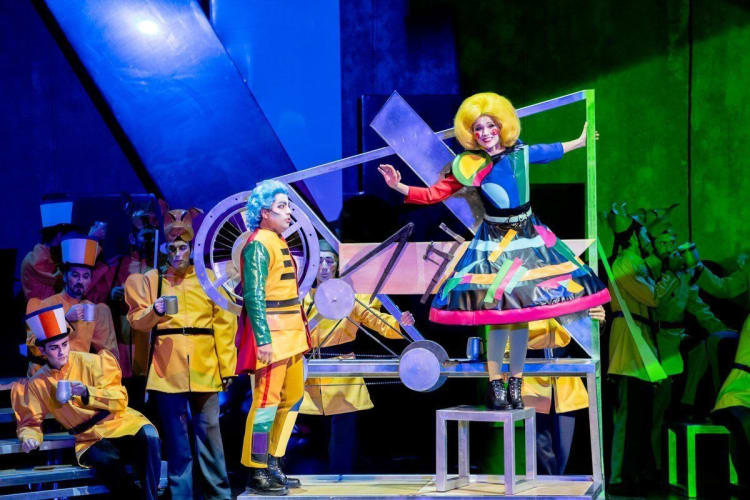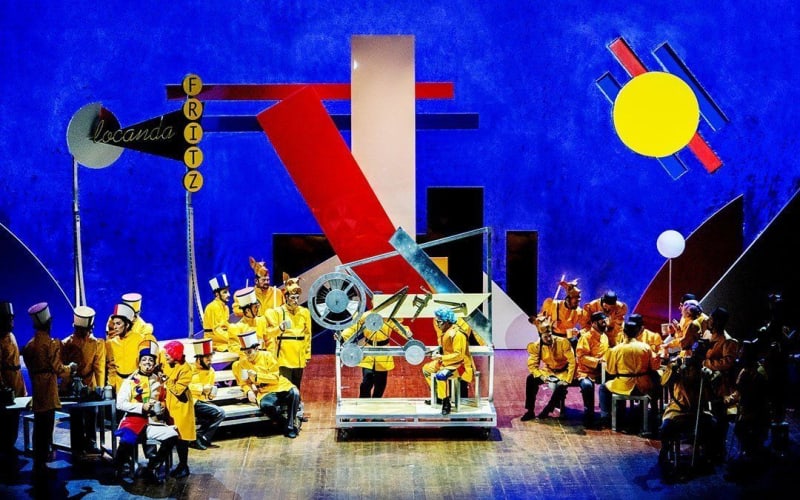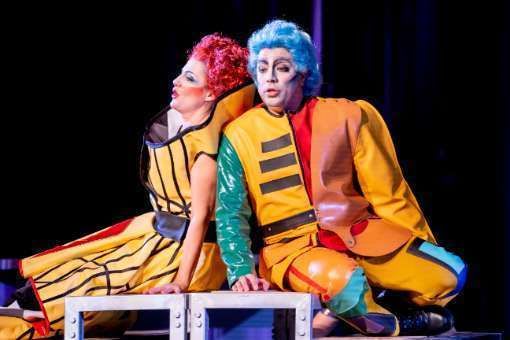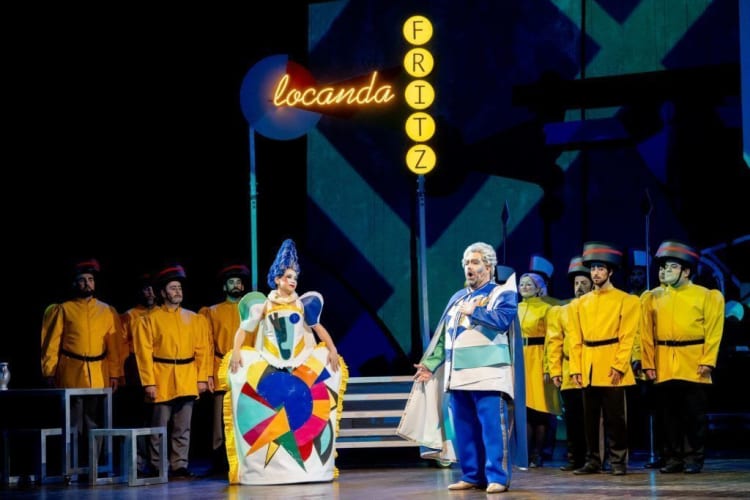When his amateur librettist, the splendidly-named Marquis Gherardo Bevilacqua Aldobrandini, wanted to insert a Russian pantomime of ‘mostly trumpets and barbarian whistles’ into this story of Peter the Great, the 22-year-old Donizetti had the temerity to resist.
But if the young composer was reluctant to go too far, Ondadurto Teatro has had no such inhibitions, playing this early opera, Donizetti’s fourth, as a psychedelic farce. It’s a constant swirl of kaleidoscopic lighting, moving scenery and eccentric costumes that owe a lot to the abstract paintings of Wassily Kandinsky.
It’s an odd choice of period, but there’s much that seems out of place in this bizarre production for the 2019 Donizetti Festival that includes, inexplicably, a trapeze artist performing alongside one of the soloists for her only aria. It’s nonsense, but fun.
The story concerns a visit by the Tsar and Tsarina to the Baltic state of Livonia in search of her lost brother, who turns out to be a carpenter, Carlo. He wants to marry Annetta, who—naturally enough in opera—is the daughter of the Tsar’s enemy, the Cossack hetman Mazeppa. But all is happily resolved by the news of the latter’s timely death.
The piece is conventionally structured, with mostly one aria for each of the six principals, three duets (although none for the lovers), a sextet and a male chorus.
All but one of the characters have as much depth as cardboard cut-outs, the exception being Madama Fritz, a generous-hearted inn-keeper who has taken care of Carlo since his rescue as a child, and who blesses his marriage to his sweetheart, although she would like to marry him herself.
Donizetti reserves for her some of his best music, beautifully rendered here by mezzo Paola Gardina. Her light opening cavatina shows both early signs of the composer’s originality and the dancing quality of her voice, whereas her vibrant legato duet with Marco Filippo Romano’s venal magistrate Sir Cuccupis is smoothly seductive.
She is the only singer granted a second aria, for her farewell to Carlo. Her "In questo estremo amplesso", affectingly delivered, and the forceful cavatina that follows, point forward to Donizetti’s great tragic heroines of the future.
Romano is the other star performer, both for his agile and precise coloratura singing and gift for comedy as the despicable magistrate, by turns cruel, susceptible and fawning. Romano works himself up into a frenzy in a cavatina about legal severity that could have been written by Rossini.
Most of the words, however, were not from his compatriot but shamelessly pinched by the librettist from Da Ponte's tirade for another scheming lawyer, Bartolo, in The Marriage of Figaro: "Se tutto il codice dovessi svolger" (If I have to search the whole legal code). Aldobrandini even has the nerve to have his chorus name Bartolo directly when they cite a model whose example the magistrate should follow.
The other musical highlight is the tuneful act 2 sextet in the middle of which each of the principals gets a brief blow, rather like the soloists in a jazz orchestra.
Francisco Brito as Carlo is bright and clear in coloratura, with nice trill and control of diminuendi in legato passages, but a little thin at the top of his range. The Tsaritsa’s only, short cavatina brings out the sweet mid-tones of Loriana Castellano, while Nina Solodovinkova as the doll-like Annetta displays fluidity and some ringing top notes in her only showcase.
Roberto De Candia’s Peter is heard to good effect in presto, Rossiniesque passages, their fioritura embellishments tossed off with apparent ease, but less so in slower sections where his pronounced rubato seems to surround the note without exactly arriving.
Pietro Il Grande inevitably includes some dull sections, which explains its disappearance for 175 years until a 2003 resurrection in St. Petersburg (a crude recording of its revival, sung in Russian, is available on YouTube). This, its first appearance on DVD, is however a welcome arrival to please the curious and give lovers of Donizetti an insight into the early development of the greatest of opera composers.



